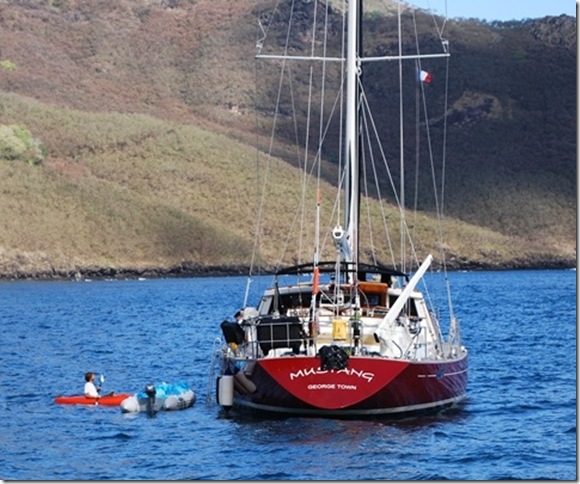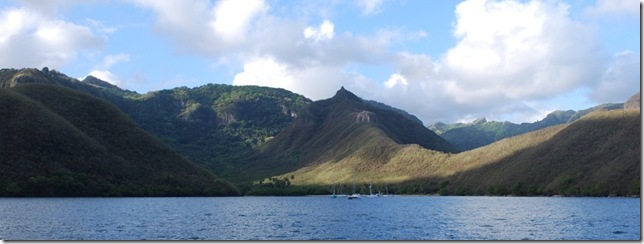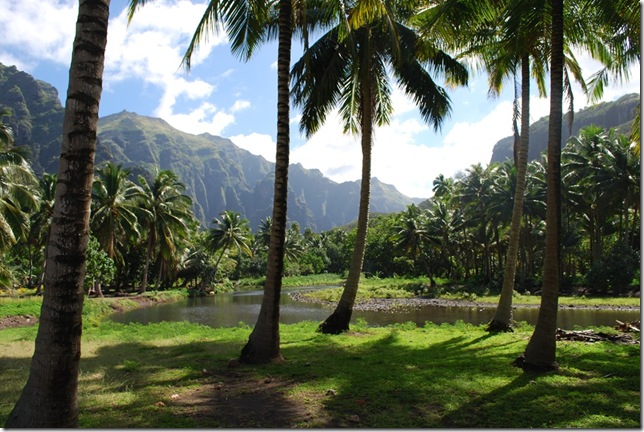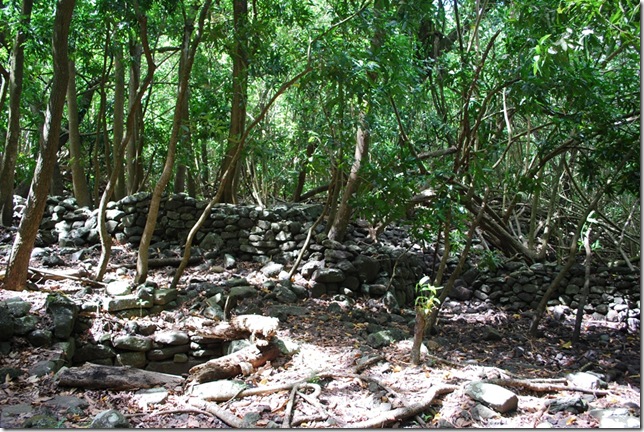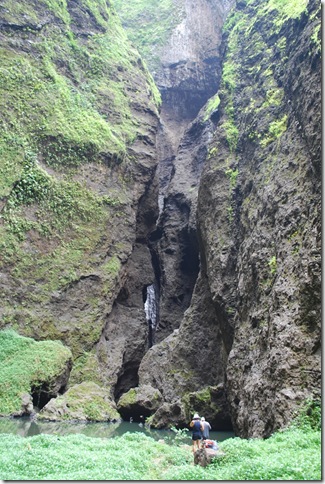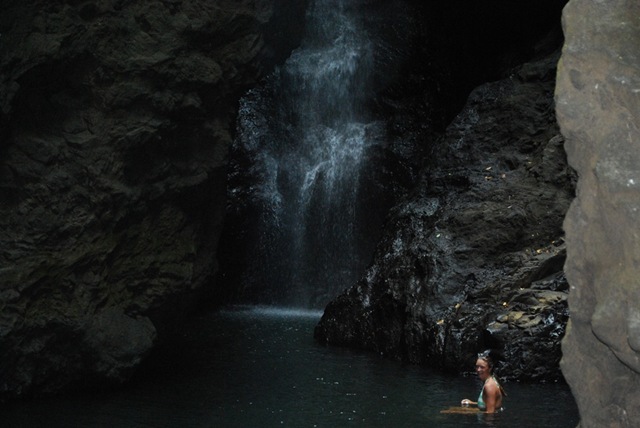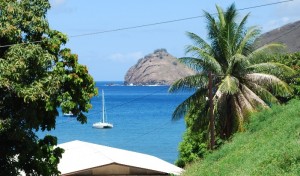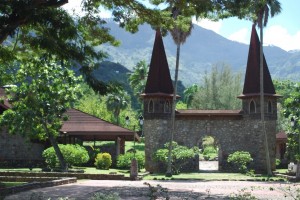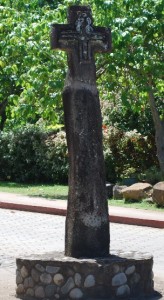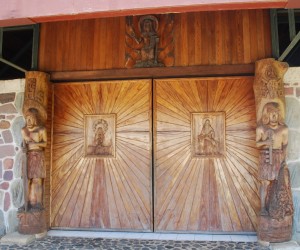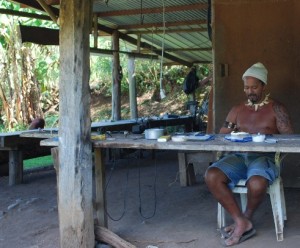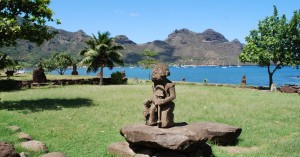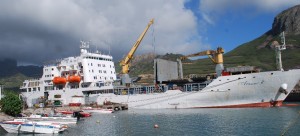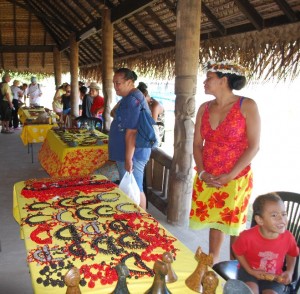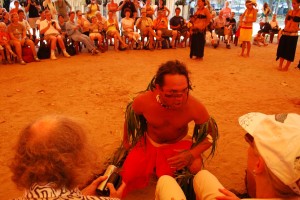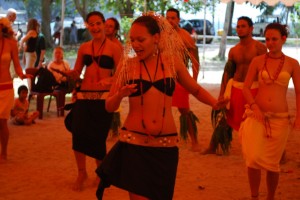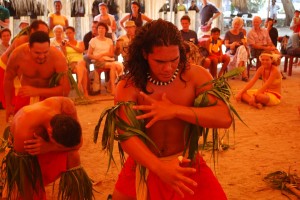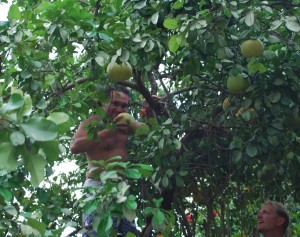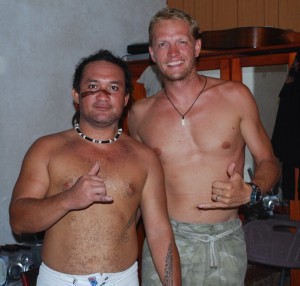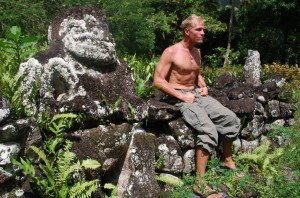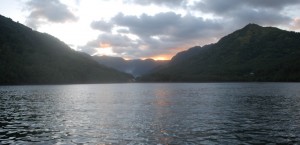Before we left Taiohae Bay, a cruising friend of ours stopped by to say hello. After making the passage from the US with his girlfriend, he’s now single-handing. Her plane took off from Nuku Hiva while we had lunch with him and talked over plans for the next few months. He’s on his way to New Zealand as well but is first heading to Eiao, an uninhabited island 30 miles north to join a boat of almost penniless young Europeans who are going to attempt to catch some wild goats and pigs without hunting weapons. It sounds as though he is definitely ready for some adventure! Nonetheless, he was well aware of the disadvantages of going it alone, and we thought we might be able to help.
Lauren and I had talked for a couple minutes with a really nice Canadian guy on the dock who had crewed on a beautiful 83′ yacht from San Francisco to Nuku Hiva after seeing the boat in Canada and asking the owner if he needed crew. The owner’s friends and family were due to join him, so Mark’s (the Canadian) gig was over, but he was doing it for experience and board and didn’t seem too eager for the adventure to end. We recommended to our cruising friend that he stop by the yacht and ask if Mark would be interested in joining him for a while. On our way out of the bay, we motored past them as they were talking and later heard on the radio that Mark had agreed to join up with our friend for a while. That was good news for all and yet another interesting tale of "How I came to sail the South Pacific" in the making.
Paul (in the kayak) and Mark talking it over
Daniel’s Bay, whose real name is Hakatea and it’s sister bay Hakaui are famous for two things. The first is Daniel, who is now dead, but earned quite a reputation for his friendliness and generosity with cruisers. He apparently had a legendary guestbook that was signed by many well-known sailors, and he was even kind enough to install a buoy in the bay with a fresh water hose run from the shore that allowed cruisers to fill their water tanks with the "best water in the world" without ever lugging a jug. The other bay, Hakaui, is also home to some very friendly Marquesans as well and is famous for a 900 foot waterfall that everybody hikes to see.
Daniel’s Bay
We started our hike about 10 in the morning after doing some laundry and a couple boat tasks. Wes pulled out a couple spare oars that we have and all four of us paddled over for some exercise. The beginning of the walk is through a beautiful area that the residents have cleared and planted. There are open-air houses and work buildings scattered by the valley road between the river and mountain. Cultivated trees and plants of numerous types are everywhere — banana, coconut, lime, pamplemousse, noni, papaya, mango, edible roots, and flowering bushes. We’d been ashore less than two minutes when Monette asked us if we’d like bananas. We answered with an enthusiastic yes, and she told us stop by after visiting the waterfall.
View from the beach back into the waterfall valley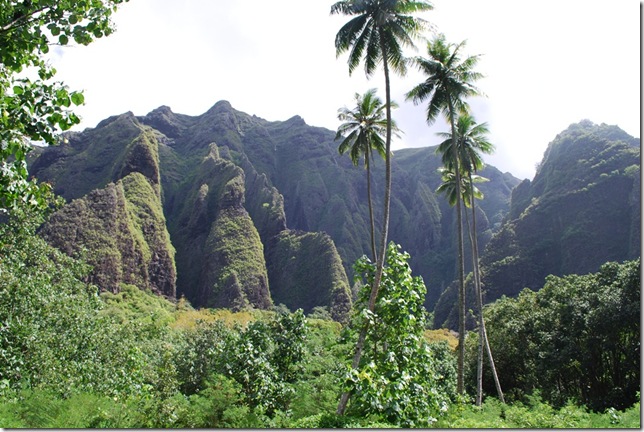
View during the walk to the wooded area
The walk to the waterfall is an unforgettable one. Our photographed cruising guide says it’s 1800 meters, but it took us almost two hours each way. The road begins as a truck path through the inhabited portion of the valley, then crosses a stream and turns into a trail. For the remainder of the walk, one is almost never out of sight of ancient ruins. Almost the entire walk is on or near an ancient stone road. After walking on and on along the ancient road with occasional stone platforms off to the side where houses or other buildings had stood, the size and sophistication of the old population begins to sink in. There were thousands in just this valley, where now less than 50 live. They built stone structures that would be unthinkable today without heavy machinery, and nearly all of them died less than 200 years ago, primarily as the victims of European germs.
After crossing the first stream, the path enters the forest beside the stream where it wanders for quite a while until it finally finds its way back to a clearing at the edge of the stream. The clearing was apparently the site of a large village, because even now very little brush grows over the stones. There are clearly walls, and paved areas as well as several square stone pits which were apparently used for storing food. At the edge of the stream, the steep and beautiful mountains again become visible. They rise almost vertically to a height of nearly 1000 feet and are covered sparsely with bright green foliage. They are so monolithic have such large folds and features that only when the white birds flying high overhead come near the peaks and turn into tiny white specks do you realize how large they really are.
Ancient ruins near the river with a food pit in the left foreground
After crossing the stream a second time the path leads into a verdant canyon walled by the high mountains. At the end of the canyon there is a pool fed by the waterfall and we all had a swim in the cool water. Most of the waterfall itself is hidden behind a fold in the cliff, but after climbing over some large rocks and swimming across another pool, you can tread water directly underneath the crashing spray as it falls the last 20 feet or so into the pool. The end of the valley is a place you want to linger, and picturesque as the ocean views are here, you can appreciate why so many people lived in the deep reaches of the valley, with the stream rushing over the boulders and the mountain cliffs towering overhead.
The waterfall and outer pool 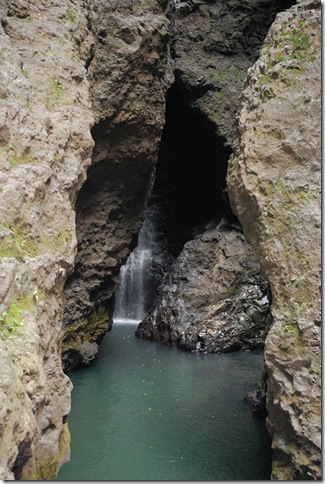 The inner pool
The inner pool
Lauren after her waterfall shower
Monette was waiting for us when we got back. She was doing yard work with her husband and son, but quickly shed her flip-flops and led us toward the house. A lot of yachties make the walk to the waterfall and she’s ready for them. She picked limes for us, handed us a stalk of bananas from among the several that were hanging from bark ropes behind the house, and gave us pamplemousse from the stack on her kitchen counter. Her house doesn’t have windows, so we conversed for a while standing outside while she was in the kitchen. It was clear she wanted to trade, so we started trying to figure out what she wanted — no to canned corn beef, small ear-rings, and used t-shirts, and yes to new t-shirts, large ear-rings, jelly, and cigarettes (but we don’t have any of these things except for jelly). After the trade discussion, she handed us half a dozen starfruit, and we headed back to the boat. Today we take the dinghy back to bring our side of the trade. We’ll probably try to trade for some more pamplemousse with the people in Daniel’s Bay as well, as we heard they’re going for $3 each in Tahiti.
Walking the capital city from end to end takes about 30 minutes. We tried stopping at the gendarmerie to check in. Although we were there on one of the three mornings that they deal with boats, they were out temporarily (I saw them wondering around the building where the art is sold, but thought someone else would be manning the station) so we’ll probably leave Nuku Hiva without checking in.
Apparently Catholic priests were the first missionaries to Nuku Hiva, as they got the prime real estate across from the mouth of the bay and atop the traditional religious site. There’s a monument at the intersection that leads to the Catholic complex that is reportedly on the site where human sacrifices used to occur. Upon abandoning their old religion, the locals built the new monument, but topped it with a clearly recognizable member of the male anatomy. Being conspicuously situated between the church and the bay, this was not exactly consistent with the priest’s sensibilities. Today, you can see a phallic-looking monument with a very old stone cross cemented to the top. The old church itself is gone, except for the facade, and a beautiful new church is built beside it. Beginning with the monument at the street, the mixture of the two religions is evident. The locations are the same. The stone road leading to the old church has tattoo rocks and ancient stones for grinding tools built into the pathway all the way to the door of the church. In the back is a shrine to the pope guarded by two tikis and featuring a pontiff with a Marquesan cross instead of the typical Christian crucifix. The door of the church is beautifully carved and also contains motifs that mix the two traditions. Inside, instead of stained glass windows, the church has open-air space between the stone walls and roof with wrought iron in the shape of Marquesan crosses and the Christian fish. The Biblical scenes usually depicted in the stained glass windows or paintings hung on the wall have been illustrated by monolithic wood carvings of the same stories.
Farther down the street was a large marae area with stone carvings that apparently was built in the last 20 or 30 years in the style of the ancient sites. There is a carver’s shed nearby where local artisans are welcome to come and work at carving wood and bone. Plenty of raw material was lying around, but only one carver was there when we stopped by. He was working on a couple of very beautifully carved pig tusks that were going to be the centerpiece of necklaces. The tusk was beautiful, but at $250, was a little out of our price range. He did tell us about a museum, so we kept walking along to the other end of town.
The museum and boutique is run by an American named Rose who sailed here from California with her husband 31 years ago. She told us he had opened the Marquesas for tourism, but she had unfortunately lost him about 15 years ago. She stayed on, collecting and documenting artifacts of historical significance, selling local art in her boutique, and building and running the hotel they had been working on together. She has a book on the Marquesas that she has nearly finished and is about to start happy hour up again at her hotel that will serve as the only yacht club in the islands. She had a great story for us about a TV show that 48 Hours did a a few years back. It was during a miserable US winter, and the show featured places you could go to get away. Her hotel was one of the places, and the bar was packed with yachties for happy hour. One American with a German accent agreed to an interview, and the next week a call came in that his wife back in the states had recognized him. It seems he had been missing for two years and officially declared dead.
After stocking up with fresh veggies at the farmer’s market, we made a dinghy trip to the local gas station on the edge of the bay, where we were able to dump our old gas and buy new. At 140 CFP per liter, we got about 11 gallons for around $80, not exactly a bargain. Our water tanks are now topped off as well, and we’re likely headed to Daniel’s Bay this afternoon, which will be our last stop in the Marquesas.
Lauren and I ended the day with dinner at the Moana Nui (Big Ocean) Hotel, which has the only wood-fired pizza oven in the Marquesas. The salad and pizza were great, but we made the mistake of getting the vegetarian pizza without asking what the topping “du jour” were. So, while I looked over the sign advertising pizzas with mushrooms, tomatoes, olives, and onions (which I love), we ate a pizza topped with heavy helpings of cabbage, shredded carrots, green beans, cucumbers, three olives, and tomato. You could visit all of the stores in town in about half an hour, and they’re all supplied by the same boat. Having just been to the store, it was clear that the vegetables du jour were the cheapest on the island, but they were plentiful and the pizza was otherwise excellent.
With its cool night air and nice breeze, Haaga Haa Bay (Tai Pi Valley) enticed us to stay another night, the last of July. We now have three months until we set sail for New Zealand at the beginning of November to avoid the summer cyclone (hurricane) season in the western South Pacific. We’ve met one single-hander in Ua Pou who was half-heartedly trying to make Australia and the Torres Strait by October, but everyone else we’ve talked to since Panama is either staying in the South Pacific or headed to New Zealand for the season, with the majority choosing New Zealand.
Our Plan A was to make Australia by October after crossing the Pacific and then to proceed on across the Indian Ocean, but repair delays led us to choose to spend the season in New Zealand instead so that we could enjoy the South Pacific at a slower pace. Our current plan is to leave the Marquesas in the next few days and stop in the Tuamotus on the way to Tahiti, which is about 750 miles from here. From Tahiti, there are several more of the Society Islands (Bora-Bora being the most well-known) to visit before finally leaving French Polynesia. West of French Polynesia are the Cook Islands, followed by the small, one-island nation of Niue and the the northern Tonga islands. If we make it past Tonga before heading to New Zealand, Fiji, Samoa, and the islands of Wallis and Futuna are all options.
The motorsail from Haaga Haa Bay to Taiohae Bay only took a couple of hours and included the beautiful views typical of the Marquesas. The cluster of three bays we had been anchored in was especially steep-walled and picturesque in its ruggedness.
Taiohae Bay is the capital of the Marquesas and its largest “city” at about 1800 or so. That’s small by American standards, but it does have a bit of a big city feel to us at this point. There are actually several tourist and boat-related businesses on the dock. Although there is no marina here, there are 20 or so boats anchored around the bay, including some pretty large sailboats. The main road along the beach is busy enough that people walk on a path beside the road instead of on the road itself for a change. The bay itself is very large, U-shaped, and open to the south. Like most of the bays here, it was once the crater of a volcano. We generally don’t set a stern anchor unless the anchorage is tightly packed, so we’re anchored away from the side of the bay where the dock is and closer to the middle of the bay, across from the east edge of the mouth. In addition to having room to swing without being near other boats, I was hoping we’d be more exposed to the breeze here. Unfortunately, although there typically is a breeze, it’s often blowing across the beam of the boat, which is being oriented by the tidal current as much as the wind, and doesn’t cool things as well down below.
We spent most of yesterday afternoon and today enjoying our first reliable, high-speed internet connection since the Galapagos. We had a chance to Skype with friends and family, and it was good to hear their voices for the first time in 6 weeks or so. We definitely enjoy taking advantage of the advances of just the last 10-15 years that allow a video conference between the US and our boat anchored here in a bay on Nuku Hiva. While we were talking, we could hear a Sunday sing-along type of event that sounded like a larger version of the one we found in Hakahetau last Sunday. The harmonizing voices, quickly-strummed ukuleles, and rhythmic pahus carried out over the bay from a public building on the hillside for several hours. We read in a cruising guide that the people of the South Pacific love to sing, and it’s true. They also love the guitar and ukulele, and we often see them passing one around and teaching each other a chord or song. Although bands for more formal entertainment may feature a keyboard and electric guitars, the more informal and traditional singing that we’ve seen has all been done with just the ukulele, guitar, and pahu. It’s common for anyone sitting nearby to suggest or start a song and for instruments to change hands occasionally when someone is inspired or gets up for a break.
I also downloaded the weather forecast today and found that our days of beautiful, consistent tradewind sailing are numbered. Jimmy Cornell’s book says as much, but seeing the GRIB data overlaid on a chart brought things home. On the way to Tahiti we’ll enter a region that is far enough south to be impacted by fronts south of the trades. We’ll also be entering the South Pacific Convergence Zone (SPCZ), which I’m not extremely conversant with, but is basically a region that allows non-tradewind weather like winds from the west, low pressure regions, etc. It looks like we’ll be back to watching the weather.
The boat has been doing pretty well lately, so we shouldn’t have much to do to get ready for the passage to the Tuamotus, although we definitely need to get some fresh gasoline. We hadn’t had the need to fill the dinghy’s outboard engine since Key West and found out two days ago that the gas in our jerry jug is bad. It’s making the outboard smoke, dumping fuel with the exhaust, and will only run with the choke open, so we’re going to pick some fresh stuff up tomorrow.
Even with all of the motoring and motorsailing we’ve been doing between bays here, we’ve only put 40 hours or so on the two diesel engines combined since we left the Galapagos. Anchorage-to-anchorage, our 3000 mile passage to Hiva Oa only used about 3 gallons of diesel, which is probably the best “mileage” I’m ever going to get.
Somehow we managed to let the week go by without blogging. In the meantime, I hope that you were able to enjoy the pictures that Dallas uploaded to illustrate some of our recent posts from the Marquesas. Wait until you see the rest of the photos from Ua Pou!
Here’s a quick(?) synopsis of the week’s activities. We awoke on Tuesday expecting to find the Ara Nui cruise ship at the dock, but it wasn’t there. We took care of some laundry (it’s getting easier), baked some brownies for Moana and his family, and eventually headed into town to find Moana and get the scoop on when we could expect to see the dancing and art displays for the tourists onboard the big ship. We located Moana in his backyard building a cage for one of his prized roosters. (This is quite rare here, as most of them roam freely or are tied by the leg to a tree.) He informed us that the Ara Nui had changed its schedule and would be there the following morning. We reasoned that since we had returned to Hakahau just for the show, we might as well stick around for another day to check it out. We were glad that we did.
The Ara Nui is pretty funny looking. The back half looks like a typical but somewhat small cruise ship, but the foreward half is clearly designed for commerce, complete with a crane and a large ramp for vehicles. It brings supplies as well as tourists from Tahiti twice per month and helps to stimulate the local economy.
Much of the village appeared to be involved in the activities for the tourists. First there were the artisans and food vendors. It didn’t look like much food was being sold that morning, but the artisans seemed to be doing very well. They displayed several varieties of jewelry, the most unique of which showed traditional Marquesan symbols carved into wooden beads. There were also hats woven from pandanus palm fibers, tiki sculptures made from polished wood that reflected different colors depending on how it was held, some very beautiful stone pieces that were way out of our price range (a small stone fish was $450!), and some wall art made from tapa, the ecru cloth that is created from pressing the bark of the mulberry tree.
The art was displayed under the tent where we had watched the Tahitian dancing the previous Friday, and tourists started to meander into the nearby restaurants. We spotted Moana inside one of them putting on traditional-looking garments (a fake tattoo across his left cheekbone and nose, leaves around the ankles and arms). He called us over and began to play the guitar for us and the young girls who were also preparing to dance. We were then joined by our new friends from the state of Washington who are onboard S/V Kattywampus. They finished building a new modern though mini (400 square foot) house out of metal and glass (no painting necessary, just get out the hose) just days before their long passage to the Marquesas. I guess they will be highly accustomed to small spaces after 3 years of living afloat.
Then it was time for the entertainment. Moana and several others began to play traditional Marquesan songs on guitar, ukelele, and pahu, while several young dancers began the hip-swaying that we typically associate with Hawaiians in grass skirts. It’s awfully similar, although Moana would probably beg to differ. Anyway, the second part was very unique to us: Moana and three other men with no shirts and leafy adornments came out waving spears and chanting. Moana apparently played the part of the tribal chief getting his warriors ready for battle against the Europeans. He was pretty intimidating as he shouted in the tourists’ faces, many of whom were European! The rest of the songs involved some juxtaposition of the impassioned chanting and sharp, full-body movements of the men with the serene cooing and flowing gestures of the girls.
Moana was pretty exhausted from having to pretend to be so intimidating but wanted to hang out with us anyway. We walked back to his house so that he could clean up at which point we learned that he has been listening to the CD that we made for him on a regular basis. In fact, he listens to Sarah MacLachlan every night before bed! For those of you who aren’t familiar with her music, she sings beautiful songs about lost love, etc. in a very soprano voice that is not intimidating whatsoever. I guess even tribal warriors have their soft spots.
Speaking of soft spots, all of us on Pura Vida have developed one for Moana during our several days in Ua Pou and were sad to say our good-byes on Wednesday evening. We had been having trouble trying to think of a parting gift for him until he expressed an interest in learning to play slide guitar. Dallas happened to have a glass slide to give him, so now Moana can play Marquesan country music.
One last musical note: Moana tipped us off to two local radio stations, one out of the Marquesas and the other out of Tahiti. We have been really surprised by the variety–everything from traditional Polynesian to reggae to French dance music to American R & B. Right now they just played James Brown’s “I Feel Good” followed by a reggae remix of Pink Floyd’s “Wish You Were Here.”
Yesterday we got up early and sailed 25 miles north to Nuku Hiva. We arrived here in the Bay of Tai Pi well before sunset and anchored in the middle of the large but shallow U-shaped bay similar to a fjord with steep mountains on either side. We relaxed last night and enjoyed the extraordinarily cool breeze…still haven’t figured out the physics of why it is cooler here, but we appreciate it to the extent that we decided to stay for a second night.
The four of us rowed ashore this morning in a zig-zag pattern as a result of the shallow water and current. Dallas and I then went on what the cruising guide had warned was a “death march” up the mountain to some well reknowned tikis. It wasn’t too bad for us young whipper-snappers, and the almost life-sized stone tikis (ancient carvings of the gods thought to offer protection to the village) were well worth seeing. Afterward we went searching for the lake that Herman Melville wrote about in Typee, his account of his two months here in the late 1800’s. He talked of his enchantment with the beautiful Marquesan “river nymphs” gliding effortlessly through the water, so naturally, Dallas wanted to see it for himself! Unfortunately, though, after following one man’s instructions and walking for a couple of miles inland, we were stopped by a group in a pickup who informed us there was no lake along that road. We think the truth lies somewhere in between (i.e., there is probably a lake several miles inland), but we settled for a picnic lunch in the river sans nymphs.
Sparsely populated, rural Taipivai (pop. 300 or so) appears to extend several miles inland, and the townspeople seem to have larger spreads than we’ve seen in other villages. Their houses were almost all well maintained with flowers and fruit-growing trees in the yards. And then there’s the animals. Most families in the Marquesas seem to have many of them including pigs, chickens, and even horses ready to be slaughtered. Moana told us that his family eats meat or fish at every meal, and none of it is pre-packaged in cellophane like it is in the U.S. Ever since we were given a hunk of pig back in Hiva Oa, I have been very cognizant of how different our meat-eating habits are from those on the islands. I wonder how many of you would consider vegetarianism if you had to slaughter, skin, and clean all of your meat products?!
Tomorrow we head to Bay Taihoe, the largest bay in the Marquesas. It should be fun to spend Saturday night in the “big city”. What’s more, we should have a fast, reliable internet connection for the first time since the Galapagos! With any luck, we’ll get updated on posting pics and even get to skype with some of you.


